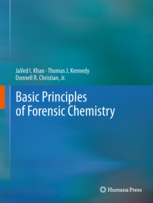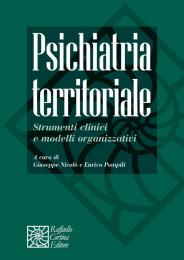Non ci sono recensioni
- Focuses on a novel approach that blends chemistry with forensic science
- Covers the examination of controlled substances and clandestine operations
- Includes Lab Manual for practical, hands-on exercises
Basic Principles of Forensic Chemistry is designed to provide a clear and concise understanding of forensic chemistry. The text begins with an introduction to the basic principles of chemistry and expands through organic chemistry into forensic investigation. The detailed chapters focus on both the theoretical and practical aspects of forensic chemistry with emphasis on controlled substance testing and identification. Leading experts in the field contribute general examination techniques followed by applications to more specific models. In addition, the text contains a comprehensive collection of information and data on controlled substances commonly encountered in forensic investigation including; detailed structural analysis, physical and physiological effects, functional group reactivity, and results of analytical examination. Also illustrated is arguably the greatest challenge to the forensic chemist: the investigation and processing of clandestine laboratory operations. The Forensic Chemistry Laboratory Manual is included on a CD-ROM and contains a collection of practical exercises designed to support theoretical principles covered in the text. This provides the student with valuable hands-on experience while adding clarity and continuity to the topics of discussion.
Essential and comprehensive, Basic Principles of Forensic Chemistry provides the fundamental knowledge required for a rewarding journey into the field of forensic chemistry.
xv
Contents
Part I Introduction to Forensic Chemistry
1 Introduction............................................................................................................... 3
1.1 Forensic Chemistry.......................................................................................... 3
1.2 Scientific Investigation..................................................................................... 4
1.3 Forensic Investigation...................................................................................... 4
1.4 Properties of Matter......................................................................................... 5
1.5 Physical Properties........................................................................................... 5
1.6 Chemical Properties......................................................................................... 6
1.7 Questions.......................................................................................................... 7
2 Atomic Structure....................................................................................................... 9
2.1 Introduction...................................................................................................... 9
2.2 Periodic Table.................................................................................................. 9
2.3 Atomic Structure.............................................................................................. 10
2.4 Subatomic Particles.......................................................................................... 11
2.5 The Arrangement of Electrons in an Atom...................................................... 12
2.6 Electron Configurations................................................................................... 13
2.7 Periodic Trends: Understanding the Periodic Table......................................... 17
2.8 Isotopes............................................................................................................ 18
2.9 Radioactivity.................................................................................................... 18
2.10 Types of Radioactive Decay............................................................................. 19
2.11 Nuclear Radiation: Forensic Applications....................................................... 19
2.12 The Mole and Molar Mass............................................................................... 20
2.13 Elements of Forensic Interest........................................................................... 20
2.14 Questions.......................................................................................................... 20
Suggested Reading...................................................................................................... 21
3 Molecules................................................................................................................... 23
3.1 Introduction........................................................................................................ 23
3.2 Chemical Bonding............................................................................................. 23
3.2.1 Ionic Bonds.......................................................................................... 23
3.2.2 Covalent Bonds.................................................................................... 24
3.2.3 Polar Bonds.......................................................................................... 25
3.2.4 Hydrogen Bonding............................................................................... 26
3.2.5 Multiple Bonds..................................................................................... 26
3.3 Predicting Bond Types....................................................................................... 27
3.3.1 Nonpolar Covalent Bonds.................................................................... 27
3.3.2 Polar Covalent Bonds........................................................................... 27
xvi Contents
3.3.3 Hydrogen Bonds.................................................................................. 27
3.3.4 Ionic Bonds.......................................................................................... 27
3.4 Molar Mass........................................................................................................ 27
3.5 Molarity.............................................................................................................. 28
3.6 Chemical Reactions........................................................................................... 28
3.7 Questions............................................................................................................ 29
4 Organic Chemistry.................................................................................................... 31
4.1 Introduction...................................................................................................... 31
4.2 Classification of Organic Compounds: Functional Groups............................. 31
4.2.1 Alkanes.............................................................................................. 32
4.2.2 Alkenes.............................................................................................. 37
4.2.3 Alkynes.............................................................................................. 39
4.2.4 Aromatic Compounds........................................................................ 40
4.2.5 Alcohols............................................................................................. 41
4.2.6 Ketones.............................................................................................. 44
4.2.7 Aldehydes.......................................................................................... 46
4.2.8 Carboxylic Acids............................................................................... 47
4.2.9 Esters.................................................................................................. 49
4.2.10 Nitro Compounds............................................................................... 50
4.2.11 Amines............................................................................................... 51
4.3 Methyl Group (–CH3)...................................................................................... 54
4.4 Compounds Containing Multiple Functional Groups...................................... 54
4.5 Chirality........................................................................................................... 55
4.6 Questions.......................................................................................................... 56
Suggested Reading...................................................................................................... 57
Part II Tools of Forensic Chemistry
5 Forensic Language ................................................................................................... 61
5.1 Defining Drugs................................................................................................. 61
5.2 Origin of Drugs (Narcotics)............................................................................. 61
5.2.1 Natural Drugs....................................................................................... 61
5.2.2 Synthetic Drugs.................................................................................... 61
5.2.3 Psychotropic Drugs (Mind Altering)................................................... 61
5.3 Dependence and Addiction.............................................................................. 62
5.3.1 Physical Dependence........................................................................... 62
5.3.2 Psychological Dependence.................................................................. 62
5.4 Drug Abuse...................................................................................................... 63
5.5 Hazards of Drug Abuse.................................................................................... 63
5.6 Structural Relationships................................................................................... 64
5.6.1 Analogs................................................................................................ 64
5.6.2 Designer Drugs.................................................................................... 64
5.6.3 Isomers................................................................................................. 65
5.7 Controlled Substance Statutes.......................................................................... 66
5.7.1 Controlled Substances Act................................................................... 66
5.7.2 Controlled Substances Laws................................................................ 66
5.7.3 Controlled Substance: Charges and Offenses...................................... 67
5.8 Controlled Substance Submission to Crime Laboratories............................... 67
5.9 Drug Cases in Crime Laboratories................................................................... 68
5.10 Examination of Controlled Substances............................................................ 69
5.11 Usable Quantity............................................................................................... 69
5.12 Court Testimony............................................................................................... 69
5.13 Qualifications and Education........................................................................... 69
5.14 Questions.......................................................................................................... 70
Suggested Reading...................................................................................................... 70
Contents xvii
6 Forensic Documentation........................................................................................... 71
6.1 Introduction...................................................................................................... 71
6.2 Chain of Custody............................................................................................. 71
6.3 Case Notes....................................................................................................... 72
6.3.1 Types.................................................................................................... 72
6.3.2 Purpose................................................................................................. 74
6.3.3 Content................................................................................................. 74
6.3.4 Format.................................................................................................. 75
6.3.5 Dissemination....................................................................................... 75
6.4 Case Report...................................................................................................... 75
6.4.1 Purpose................................................................................................. 75
6.4.2 Format and Content.............................................................................. 75
6.5 Examples.......................................................................................................... 76
6.5.1 Example One........................................................................................ 76
6.5.2 Example Two....................................................................................... 76
6.6 Questions.......................................................................................................... 76
Suggested Reading...................................................................................................... 77
7 Chemical Screening.................................................................................................. 79
7.1 Introduction...................................................................................................... 79
7.2 Chemistry of Color Formation......................................................................... 79
7.3 Limitations of Chemical Color Tests............................................................... 81
7.4 Chemical Color-Test Methods......................................................................... 81
7.5 Documentation................................................................................................. 82
7.6 Chemical Color Tests....................................................................................... 82
7.6.1 Chen’s Test......................................................................................... 82
7.6.2 Dille–Koppanyi’s Test....................................................................... 83
7.6.3 Mecke’s Test...................................................................................... 83
7.6.4 Marquis’ Test..................................................................................... 84
7.6.5 Nitric Acid Test.................................................................................. 85
7.6.6 Primary Amine Test........................................................................... 86
7.6.7 Secondary Amine Test....................................................................... 86
7.6.8 Tertiary Amine Test........................................................................... 86
7.6.9 Van-Urk’s Test................................................................................... 86
7.6.10 Duquenois–Levine Test..................................................................... 87
7.6.11 Froehde’s Test.................................................................................... 87
7.6.12 Janovsky Test..................................................................................... 87
7.6.13 Weber Test......................................................................................... 88
7.7 Summary of Chemical Color Tests.................................................................. 88
7.8 Questions.......................................................................................................... 90
Suggested Reading...................................................................................................... 90
8 Microcrystal Techniques.......................................................................................... 91
8.1 Introduction........................................................................................................ 91
8.2 Advantages of Microcrystal Techniques............................................................ 91
8.3 Disadvantages of Microcrystal Techniques....................................................... 92
8.4 Documentation................................................................................................... 92
8.5 Microcrystal Test Techniques............................................................................ 94
8.5.1 Aqueous Test Technique...................................................................... 94
8.5.2 Volatility Test Technique...................................................................... 95
8.5.3 Acid and Anionic Test Technique........................................................ 95
8.6 Aqueous Test Reagents...................................................................................... 95
8.6.1 Gold Chloride Test............................................................................... 95
8.6.2 Gold Chloride in Phosphoric Acid Test............................................... 95
8.6.3 Platinum Chloride Test......................................................................... 96
xviii Contents
8.6.4 Mercuric Iodide Test............................................................................ 96
8.6.5 Mercuric Chloride Test........................................................................ 96
8.6.6 Potassium Permanganate Test.............................................................. 96
8.6.7 Sodium Acetate Test............................................................................ 96
8.7 Critical Considerations..................................................................................... 96
8.8 Questions.......................................................................................................... 97
Suggested Reading...................................................................................................... 97
9 Chemical Extractions and Sample Preparation..................................................... 99
9.1 Introduction...................................................................................................... 99
9.2 Techniques....................................................................................................... 99
9.2.1 Solid–Liquid Extraction....................................................................... 99
9.2.2 Liquid–Liquid Extraction..................................................................... 100
9.2.3 Acid–Base Extraction........................................................................... 101
9.2.4 Neutral Compound Extraction.............................................................. 102
9.3 Sample Preparation.......................................................................................... 103
9.4 Gas Chromatography/Gas Chromatography Mass Spectrometry.................... 103
9.5 Dry-Extraction Gas-Chromatography Modification........................................ 104
9.6 Acid–Base-Extraction Gas-Chromatography Modification............................. 104
9.7 Infrared Spectroscopy...................................................................................... 104
9.8 Acid–Base-Extraction Infrared-Modification-I............................................... 105
9.9 Acid–Base-Extraction Infrared-Modification-II.............................................. 105
9.10 Methanol Extraction......................................................................................... 105
9.11 Questions.......................................................................................................... 106
Selected Reading......................................................................................................... 106
10 Chromatography and Mass Spectrometry............................................................. 107
10.1 Introduction...................................................................................................... 107
10.2 Chromatographic Techniques.......................................................................... 107
10.2.1 Paper Chromatography....................................................................... 107
10.2.2 Thin-Layer Chromatography.............................................................. 109
10.2.3 Column Chromatography................................................................... 110
10.2.4 Ion-Exchange Chromatography.......................................................... 110
10.2.5 High-Performance Liquid Chromatography....................................... 111
10.2.6 Gas Chromatography.......................................................................... 112
10.2.7 Chromatography: Limitations............................................................ 115
10.2.8 Interpretation of GC Chromatograms................................................. 115
10.3 Mass Spectrometry........................................................................................... 116
10.3.1 Ionization............................................................................................ 117
10.3.2 Electron Impact.................................................................................. 117
10.3.3 Chemical Ionization............................................................................ 118
10.3.4 Mass Spectral Fragmentation............................................................. 118
10.3.5 Mass Analyzers (Filters)..................................................................... 119
10.3.6 Quadrupole Mass Analyzers............................................................... 119
10.3.7 Magnetic Sector Mass Analyzers....................................................... 123
10.3.8 Ion Trap Mass Analyzers.................................................................... 123
10.4 Advantages of Gas Chromatography Mass Spectrometry............................... 124
10.5 Disadvantages of Gas Chromatography Mass Spectrometry........................... 124
10.6 Questions.......................................................................................................... 125
Suggested Reading...................................................................................................... 125
11 Infrared Spectroscopy.............................................................................................. 127
11.1 Introduction...................................................................................................... 127
11.2 Theory of Infrared Spectroscopy..................................................................... 127
11.3 Infrared Spectrum............................................................................................ 129
Contents xix
11.4 Instrumentation.............................................................................................. 129
11.4.1 Dispersive Infrared Spectrometer..................................................... 129
11.4.2 Spectrometer Components............................................................... 129
11.4.3 Spectrometer Design........................................................................ 131
11.4.4 Limitations of Dispersive Infrared................................................... 132
11.5 Fourier Transform Infrared Spectrometer....................................................... 132
11.5.1 Spectrometer Components............................................................... 133
11.5.2 Spectrometer Design........................................................................ 133
11.5.3 Advantages of Fourier Transform Infrared Spectrometers.............. 134
11.5.4 Fourier Transform Infrared Sample Preparation Techniques........... 134
11.6 Sampling Techniques..................................................................................... 136
11.6.1 Nujol Mull........................................................................................ 136
11.6.2 Cast Film A...................................................................................... 136
11.6.3 Cast Film B...................................................................................... 136
11.6.4 Pellets............................................................................................... 136
11.6.5 Synthetic Membrane Sample Cards................................................. 137
11.7 Reflectance..................................................................................................... 137
11.8 Fourier Transform Infrared Spectroscopy...................................................... 137
11.9 Advantages of Fourier Transform Infrared Spectroscopy.............................. 137
11.10 Disadvantages of Fourier Transform Infrared Spectroscopy......................... 137
11.11 Instrument Selection for Forensic Identification............................................ 137
11.12 Inorganic Analysis......................................................................................... 138
11.13 Organic Analysis............................................................................................ 139
11.14 Questions........................................................................................................ 141
Suggested Reading...................................................................................................... 141
Part III Examination of Drugs/Narcotics
12 Cannabis.................................................................................................................... 145
12.1 Introduction...................................................................................................... 145
12.2 History.............................................................................................................. 145
12.3 Packaging for Forensic Examination............................................................... 147
12.4 Forms of Cannabis........................................................................................... 147
12.5 Psychoactive Ingredient................................................................................... 147
12.6 Forensic Identification of Marijuana................................................................ 149
12.6.1 Botanical Identification...................................................................... 149
12.6.2 Macroscopic Properties...................................................................... 149
12.6.3 Microscopic Identification.................................................................. 151
12.6.4 Chemical Identification (Duquenois–Levine Test)............................. 151
12.6.5 Thin-Layer Chromatography.............................................................. 153
12.6.6 Gas Chromatography Mass Spectrometry.......................................... 154
12.7 Documentation................................................................................................. 154
12.8 Questions.......................................................................................................... 156
Suggested Reading...................................................................................................... 156
13 Phenethylamines....................................................................................................... 157
13.1 Introduction...................................................................................................... 157
13.2 Methyl Derivatives........................................................................................... 157
13.2.1 Amphetamine..................................................................................... 158
13.2.2 Methamphetamine.............................................................................. 159
13.2.3 Phentermine........................................................................................ 161
13.3 Hydroxyl Derivatives....................................................................................... 162
13.3.1 Phenylpropanolamine......................................................................... 162
13.3.2 Ephedrine/Pseudoephedrine............................................................... 163
13.3.3 Ephedra Plant: Introduction and History............................................ 164
xx Contents
13.4 Ketone Derivatives........................................................................................... 164
13.4.1 Cathinone............................................................................................ 164
13.4.2 Methcathinone.................................................................................... 165
13.4.3 Khat.................................................................................................... 165
13.5 Methylenedioxy Derivatives............................................................................ 166
13.5.1 3,4-Methylenedioxyamphetamine...................................................... 167
13.5.2 3,4-Methylenedioxymethamphetamine.............................................. 167
13.6 Methoxy Derivatives........................................................................................ 168
13.6.1 Mescaline............................................................................................ 168
13.7 Analytical Methods.......................................................................................... 170
13.7.1 Visual Inspection................................................................................ 170
13.7.2 Chemical Screening............................................................................ 170
13.7.3 Microcrystal Tests.............................................................................. 170
13.7.4 Extraction Techniques........................................................................ 171
13.7.5 Extraction of Mescaline from Peyote................................................. 172
13.7.6 Confirmatory Examination................................................................. 172
13.8 Questions.......................................................................................................... 175
Suggested Reading...................................................................................................... 175
14 Tertiary Amines......................................................................................................... 177
14.1 Introduction...................................................................................................... 177
14.2 Natural Tertiary Amines................................................................................... 177
14.2.1 Cocaine............................................................................................... 177
14.2.2 Opiates................................................................................................ 179
14.3 Synthetic Tertiary Amines................................................................................ 182
14.3.1 Phenylcyclohexylpiperidine............................................................... 182
14.4 Analytical Methods.......................................................................................... 183
14.4.1 Visual Inspections............................................................................... 183
14.4.2 Chemical Screening of Tertiary Amines............................................ 183
14.4.3 Confirmatory Examination................................................................. 185
14.5 Questions.......................................................................................................... 190
Suggested Reading...................................................................................................... 190
15 Tryptamines............................................................................................................... 191
15.1 Introduction...................................................................................................... 191
15.2 Natural Tryptamines........................................................................................ 192
15.2.1 Psilocin and Psilocybin (Psychoactive Mushrooms).......................... 192
15.2.2 Bufotenin............................................................................................ 193
15.2.3 Methoxy Derivatives........................................................................... 195
15.3 Synthetic Tryptamines..................................................................................... 197
15.4 Analytical Methods.......................................................................................... 197
15.4.1 Visual Identification............................................................................ 197
15.4.2 Chemical Screening Tests................................................................... 198
15.4.3 Extraction of Psilocin and Psilocybin from Mushrooms.................... 199
15.4.4 Thin-Layer Chromatography.............................................................. 199
15.4.5 Gas-Chromatography Mass Spectrometry......................................... 199
15.5 Questions.......................................................................................................... 205
Suggested Reading...................................................................................................... 206
16 Anabolic Steroids...................................................................................................... 207
16.1 Introduction and History.................................................................................. 207
16.2 Naturally Occurring Steroid Hormones........................................................... 208
16.3 Anabolic Steroids............................................................................................. 210
16.3.1 General Structure................................................................................ 210
16.3.2 Physical and Psychological Effects.................................................... 211
Contents xxi
16.3.3 Methods of Administration................................................................. 211
16.3.4 Nomenclature of Anabolic Steroids................................................... 211
16.3.5 Frequently Encountered Steroids....................................................... 212
16.4 Analytical Methods.......................................................................................... 213
16.4.1 Visual Inspections............................................................................... 213
16.4.2 Gas Chromatography Mass Spectrometry.......................................... 213
16.4.3 Mass Spectra of Commonly Encountered Steroids............................ 214
16.5 Questions.......................................................................................................... 222
Suggested Reading...................................................................................................... 222
17 Miscellaneous Controlled Substances..................................................................... 223
17.1 Introduction...................................................................................................... 223
17.2 Barbiturates...................................................................................................... 223
17.3 Fentanyl............................................................................................................ 225
17.4 Gamma-Hydroxybutyric Acid: g-Hydroxybutyric Acid.................................. 226
17.5 Ketamine.......................................................................................................... 227
17.6 Lysergic Acid Diethylamide............................................................................ 228
17.7 Analytical Methods.......................................................................................... 229
17.7.1 Visual Identification............................................................................ 229
17.7.2 Chemical Screening Tests................................................................... 230
17.7.3 Gas-Chromatography Mass Spectrometry......................................... 230
17.8 Questions.......................................................................................................... 237
Suggested Reading...................................................................................................... 237
Part IV Clandestine Laboratory Operations
18 Clandestine Operations: Synthetic Methods, Hazards, and Safety ................ 241
18.1 Introduction...................................................................................................... 241
18.2 Clandestine Operations.................................................................................... 241
18.2.1 Synthesis of Cocaine.......................................................................... 241
18.2.2 Synthesis of Fentanyl......................................................................... 242
18.2.3 Synthesis of g-Hydroxybutyric Acid.................................................. 242
18.2.4 Synthesis of Heroin............................................................................ 244
18.2.5 Synthesis of Lysergic Acid Diethylamide.......................................... 245
18.2.6 Synthesis of 3,4-Methylenedioxymethamphetamine......................... 246
18.2.7 Synthesis of Methcathinone............................................................... 247
18.2.8 Synthesis of Phencyclidine................................................................. 248
18.2.9 Synthesis of N,N-Dimethyltryptamine............................................... 248
18.3 Synthesis of Methamphetamine: The Clandestine Operation of Choice......... 249
18.3.1 Cold Method....................................................................................... 249
18.3.2 Hot Method......................................................................................... 251
18.4 Potential Hazards Associated with Clandestine Operations............................ 253
18.5 Safety Considerations...................................................................................... 253
18.6 Role of the Forensic Chemist at Clandestine Lab Sites................................... 253
18.6.1 Advisory............................................................................................. 254
18.6.2 Evidence Collection............................................................................ 254
18.7 Questions.......................................................................................................... 254
Suggested Reading...................................................................................................... 254
19 Evidence Identification and Collection................................................................... 257
19.1 Clandestine Operations: A Forensic Analogy.................................................. 257
19.2 Signs of Clandestine Operations...................................................................... 257
19.3 Identification of Related Evidence................................................................... 258
19.4 Solutions Frequently Encountered at Clandestine Sites.................................. 260
xxii Contents
19.5 Clandestine Production of Methamphetamine................................................. 261
19.5.1 Extraction of Pseudoephedrine from Cold Tablets (Step I)................ 261
19.5.2 Manufacturing of Methamphetamine (Step II)................................... 262
19.5.3 Processing of Methamphetamine (Step III)........................................ 263
19.5.4 Icing of Methamphetamine (Step IV)................................................. 263
19.6 Collection of Evidence..................................................................................... 263
19.7 Collection of Washes....................................................................................... 266
19.8 Questions.......................................................................................................... 267
Suggested Reading...................................................................................................... 267
20 Examination of Clandestine Evidence.................................................................... 269
20.1 Introduction...................................................................................................... 269
20.2 Examination of Evidence to Prove Extraction (Step I) ................................... 269
20.2.1 Evidence Type.................................................................................... 269
20.2.2 Examination........................................................................................ 270
20.3 Examination of Evidence to Prove Manufacturing
of Methamphetamine (Step II)........................................................... 270
20.3.1 Evidence Type.................................................................................... 270
20.3.2 Examination........................................................................................ 271
20.3.3 Confirmatory Examination................................................................. 274
20.4 Examination of Evidence to Prove Processing
of Methamphetamine (Step III)....................................................................... 274
20.4.1 Evidence Type.................................................................................... 274
20.4.2 Examination of Biphasic Solutions.................................................... 275
20.5 Examination of Evidence to Prove Icing (Step IV)......................................... 275
20.6 Examination of Stains...................................................................................... 277
20.7 Examination of Washes.................................................................................... 278
20.8 Determining Methods of Methamphetamine Production................................ 279
20.9 Questions.......................................................................................................... 282
Suggested Reading...................................................................................................... 282
Laboratory Manual.......................................................................................................... 283
Experiment # 2............................................................................................................ 286
Experiment # 3............................................................................................................ 288
Experiment # 4............................................................................................................ 290
Experiment # 5............................................................................................................ 292
Experiment # 6............................................................................................................ 298
Experiment # 7............................................................................................................ 300
Experiment # 8............................................................................................................ 304
Experiment # 9............................................................................................................ 310
Experiment # 10.......................................................................................................... 312
Experiment # 11.......................................................................................................... 314
Experiment # 12.......................................................................................................... 316
Experiment # 13.......................................................................................................... 320
Experiment # 14.......................................................................................................... 323
Experiment # 15.......................................................................................................... 325
Experiment # 16.......................................................................................................... 328
Experiment # 17.......................................................................................................... 332
Experiment # 18.......................................................................................................... 335
Experiment # 19.......................................................................................................... 338
Experiment # 20.......................................................................................................... 341
Index................................................................................................................................... 345




